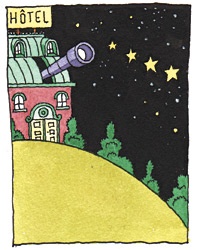 Steven Guarnaccia 5-Star Bummer
In Europe, hotel ratings may not be exactly what they seem. Sara Pepitone explains how to navigate the stars and find the room that’s right for you.
Steven Guarnaccia 5-Star Bummer
In Europe, hotel ratings may not be exactly what they seem. Sara Pepitone explains how to navigate the stars and find the room that’s right for you.
While an unexpected upgrade is welcome, it’s rarely fun to be surprised by what’s behind your hotel-room door. Enter hotel ratings, which attempt to assess hotels based on a predetermined set of objective criteria. The result: the awarding of stars and scores by myriad government, tourism, and independent authorities. (For a chart that explains official hotel ratings, and where to find them, in some of Europe’s most-visited countries, see A Guide to the Stars)
If you’ve ever picked a French, Italian, or Spanish property for the number of stars it’s received, you may know that European classifications are based on the existence (or lack) of certain facilities and amenities such as elevators, bathtubs, and armchairs. Unlike the subjective evaluations by guidebooks (think "charming" and "lovely"), European hotel ratings are designed to be objective and quantifiable—based on, for instance, the number of languages the staff speaks, room size, and ventilation. This sometimes leads to surprising results. For example, the Parador de Granada, with its historic allure and stunning location in the Alhambra Gardens, is regularly ranked as one of the best hotels in Spain by T+L readers, but it receives only four stars, not five, under Spain’s rating system, because it lacks conveniences such as an elevator and a swimming pool. Basically, stars in Europe denote minimum standards for facilities and services provided; more stars = more amenities.
But wait. Each country uses its own criteria. Consequently, three stars in England is not quite the same as three stars in Spain. Worse: three stars in Barcelona is not the same as three stars in Madrid or in Seville (each region of Spain adopts its own standards). And that’s not likely to change. International standardization, often considered by government tourism departments, hoteliers, and independent organizations, will not occur until someone can account for differences in culture and geography—not everyone agrees on what makes a good bed, or whether bathrooms should have bidets.
But it’s not just Europe. The United States doesn’t have a unified system either. In fact, the only national ratings are compiled by private companies. Mobil and AAA use hundreds of criteria—from carpet design to landscaping—to provide hotel ratings in North America (on scales of 1 to 5). And both send inspectors annually to confirm that properties—some 9,000 are reviewed by Mobil; 60,000 by AAA—maintain their standards. But even though the criteria are similar, the resulting ratings aren’t always the same. For example, Mobil gives Wynn Las Vegas four stars, while AAA gives it five diamonds.
Does all this mean that hotel ratings are worthless?The short answer is no. If you consider the limitations of the systems, you can often find a gem or a bargain. In some countries, there are tax incentives for taking a lower star rating, so a three-star hotel may actually be a four-star property in disguise. And in France, a hotel with fewer than seven rooms will never have a star—not even if it’s bejeweled. Hégia, a 1746 stone farmhouse in the foothills of the Pyrenees, is a luxe rustic retreat; with only five guest rooms, though, it will always be sans étoile.